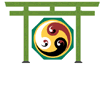
A Book of Little Traditions

|
minzoku NEO-shintô A Book of Little Traditions |
|
|
ToC |
||
|
kanji and Ancient Chinese Thought – 06 / 12 / 2014
Much of the Japanese political structure, philosophies, ethics, and religious thought were imported from China both directly and through Korea, and then uniquely incorporated into existing ways.
kan (Sino-, China)
ji (character, letter, word) kanji (Chinese characters) While aware of the concept of writing, the early Japanese ruling class had not yet developed a system capable of expressing the new ideas being imported from China and Korea. As a result, they adopted the Chinese system of kanji (Chinese characters) for writing.* Because the Chinese ideas that were embedded in the kanji were not readily separable from the kanji, the Japanese wound up adopting many of these ideas. * Note: The Japanese language is structured differently from Chinese, so this was not an ideal solution. It was only with creation of the hiragana and katakana syllabaries and their subsequent addition to kanji that a truely Japanese writing system was created. A problem caused by the adoption of Chinese kanji is that many kanji have multiple pronunciations. There are on'yomi, which are the Japanese pronunciations of the Chinese, and kun'yomi which are Japanese words for the ideas the kanji stand for.
ateji – And adding to the confusion, kanji are sometimes used for their phonetic value only, not their meaning.
hira (even, flat, peace)
ga | ka (informal) na (noted) gana (syllabary) hiragana (cursive syllabary) ❖ hiragana is used primarily for native Japanese words (esp. function words, inflections, etc.)
kata (one-sided)
ka (informal) na (noted) kana (syllabary) katakana (angular syllabary) ❖ katakana is used primarily for foreign loanwords
kun (instruction, Japanese character reading, explanation, read)
yo.mi (read) kun'yomi (Japanese reading of the kanji) ❖ Japanese words for the ideas the kanji stand for
on (sound, noise)
yo.mi (read) on'yomi (Chinese reading of the kanji) ❖ Japanese pronunciation of the Chinese pronunciation of the kanji
san (three)
kyô (teach, faith, doctrine) sankyô (Literally: three religions) ❖ A theme in Chinese and Japanese art depicting the Three Patriarchs of Chinese thought: Confucius, shakyamuni (Buddha), and Lao Tzu.
san (three)
san (acid, bitterness, sour, tart) zu (unexpected, accidentally) sansan-zu (Three Sages Tasting Vinegar) This is a popular theme in Chinese and Japanese art. One variation on this theme was to show each of the three patriarchs with different facial expressions. After tasting the vat's content, Confucius is shown with a sour face, Shakyamuni (Buddha) with a bitter expression, and Lao tsu with a smiling face. To Confucius, the father of Confucianism, life was sour and chaotic because rules and regulations were not strictly obeyed. To shakyamuni, the Historical Buddha and the patriarch of Buddhism, life was bitter, filled with suffering, sickness, old age, and death. To Lao Tsu, the father of Taoism, life is sweet, not sour or bitter, if one flows like water, without trying to dam, redirect, or interfere with the natural path of the water.
ko (tiger)
kei (valley) san (three) shô (laugh) kokei sanshô (Three Laughers of Tiger Ravine) The name usually given to a Chinese story, frequently illustrated in pictures, showing two old men taking leave of a third one at the end of a bridge, the three laughing heartily. There are several versions of it. One says, that an old philosopher retired to an island and swore never to leave it. Two of his friends used to visit him, and tried every time to make him break his vow, but in vain. Once, however, that they had whiled away the time with a more copious series of libations, the two beguiled the old man over the small bridge connecting his island with the rest of the world, and then the three made fun of it.
Another says, in the time of Hsiao Wu there lived a Chinese priest named Hui Yuan, who had a thousand pupils in the temple Tung Lin Ssu, on the mountain Lu Shan. This worthy never left the mountain for thirty years, but used to descend to Hu Hsi, halfway down, and then take leave of his visitors. Two friendly literati, Tao Yuan Ming and Liu Hsiu Ching, often visited him, and one day, in the ardour of conversation, he walked with them further than usual. They stopped and laughed when they became aware of it.
Yet another refers to the monk Eon (334-416 a.d.) of the Eastern Chin dynasty. He created the foundational texts for Chinese Buddhism. He later formed the White Lotus Society on Mt. Lu that was engaged in prayers (nenbutsu) to the Buddha of the Western Paradise. Eon spent some 30 years on Mt. Lu without ever leaving the precinct of his temple. Eon had taken a vow to stay in a cave on Mt. Lu, never to leave, never to cross the rope bridge over a chasm in front of his cave. But, when two literary giants, the greatest poets of their day, paid him a visit, he inadvertently bid them farewell by seeing them across the chasm bridge. Realizing his mistake, Eon burst into laughter.
|
||||||||||||||||||||||||||
|
|